Metastatic Cancer Drugs Market Research, 2032
The global metastatic cancer drugs market size was valued at $67.7 billion in 2022, and is projected to reach $136.9 billion by 2032, growing at a CAGR of 7.3% from 2023 to 2032. Metastatic cancer, also known as advanced or stage IV cancer, is a condition in which cancer cells have spread from the primary site of the disease to other parts of the body through the bloodstream or lymphatic system. This dissemination leads to the development of secondary tumors, known as metastases, in distant organs or tissues.
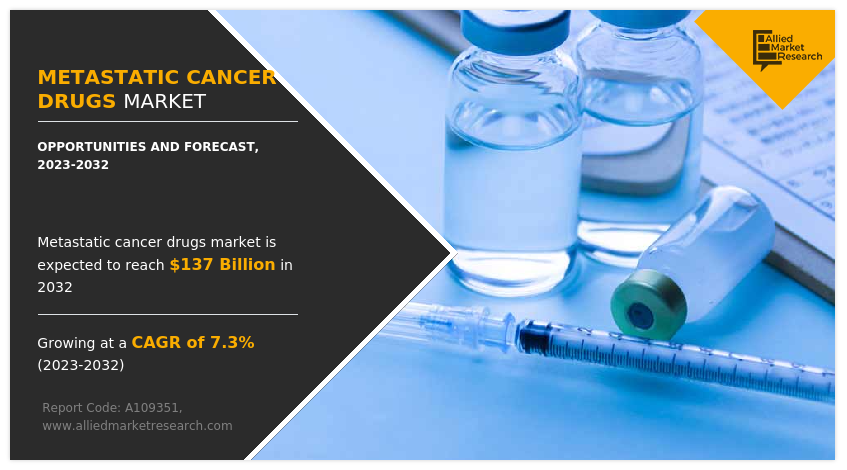
Market Dynamics
The major factors driving the growth of metastatic cancer drugs market are increasing prevalence of metastatic cancer, advancements in drug discovery and development and adoption of novel treatment options for metastatic cancer. One of the primary drivers of the market is the rising incidence of cancer worldwide. The prevalence of cancer, especially metastatic cancer, has been on the rise owing to various factors such as aging population, lifestyle changes, environmental factors and genetic predisposition. This increased incidence creates a significant demand for effective drugs to treat metastatic cancer, driving the growth of the market.
In addition, significant advancements in drug discovery and development have led to the introduction of newer and more effective treatments for metastatic cancer. The development of targeted therapies, immunotherapies and combination therapies has revolutionized the treatment landscape and improved patient outcomes. These innovative treatment options have boosted the demand for metastatic cancer drugs and contributed to metastatic cancer drugs market growth.
Further, regulatory agencies such as the U.S. Food and Drug Administration (FDA) and the European Medicines Agency (EMA), have implemented initiatives to expedite the approval process for metastatic cancer drugs. Fast-track designations, breakthrough therapy designations, and accelerated approvals have enabled quicker market entry for promising drugs. This favorable regulatory environment encourages pharmaceutical companies to invest in the development of metastatic cancer drugs, driving market growth.
Furthermore, technological advancements in diagnostic techniques such as molecular profiling, next-generation sequencing and liquid biopsy have improved the identification and characterization of metastatic cancer. These advancements help in determining specific molecular targets for personalized therapies, leading to the development of more effective drugs. The integration of artificial intelligence (AI) and machine learning (ML) in cancer research and drug development also contributes to market growth.
Moreover, significant advancements in metastatic cancer research and development have fueled the growth of the metastatic cancer drugs market. Ongoing research efforts have led to a better understanding of the molecular mechanisms underlying metastatic cancer, identification of novel targets and the development of innovative drugs. Technological advancements such as genomics, proteomics and high-throughput screening techniques, have facilitated the discovery and development of targeted therapies and personalized medicine approaches.
Further, rise in adoption of targeted therapies, which specifically target molecules and pathways involved in metastatic cancer progression, have become a cornerstone of treatment. Drugs such as trastuzumab, pertuzumab, and CDK4/6 inhibitors have shown significant efficacy in specific metastatic breast, ovarian, and prostate cancer subtypes. In addition, immunotherapies, such as immune checkpoint inhibitors, have shown promise in subsets of breast, colorectal and prostate cancer patients by harnessing the body's immune system to fight cancer cells. The development and approval of these targeted therapies and immunotherapies have expanded treatment options and contributed to market growth.
In addition, various organizations along with the government are counselling people regarding cancer and available treatment options. E-commerce (electronic commerce) has become a vital tool for small and large businesses globally, owing to a rise in preference of consumers for online shopping over traditional purchasing methods. Various animations through health apps to educate people regarding metastatic cancer and usage of medications have contributed towards the metastatic cancer drugs market growth.
However, metastatic cancer drugs, particularly chemotherapy, can cause significant side effects and toxicity. These adverse effects can impact patients' quality of life, lead to treatment discontinuation, and require additional supportive care. The tolerability and toxicity profile of drugs influence treatment decisions and patient adherence, posing challenges in optimizing treatment outcomes while minimizing side effects.
The outbreak of COVID-19 has disrupted workflows in the health care sector around the world. The pandemic has disrupted healthcare services globally, with a shift in resources and focus towards managing COVID-19 patients. Non-urgent medical procedures, including cancer screenings and treatments, have been delayed or canceled, leading to a decline in metastatic cancer diagnoses and subsequent treatment initiation. This disruption has affected the demand for metastatic cancer drugs and created challenges in patient management. Further, fear of contracting the virus and restrictions on movement have resulted in reduced patient visits to healthcare facilities. This has impacted patient adherence to treatment regimens, including metastatic cancer drugs. Interruptions in treatment and non-adherence can compromise treatment outcomes and increase the risk of disease progression.
Moreover, pandemic has caused disruptions in global supply chains, including the pharmaceutical industry. Manufacturing facilities, transportation networks, and logistics have been affected, leading to potential shortages or delays in the production and distribution of metastatic cancer drugs. Supply chain disruptions have impacted drug availability and posed challenges in meeting the demand for essential medications. Thus, COVID-19 negatively impacted to the growth of metastatic cancer drugs market.
However, as healthcare systems regain stability, efforts to recover and resume non-urgent medical services, including metastatic cancer screenings, diagnoses and treatments. This recovery phase is expected to lead to an increased demand for metastatic cancer drugs as the backlog of postponed procedures is addressed. Healthcare providers will focus on ensuring timely access to care and treatment to mitigate the impact of delayed diagnoses and treatment initiation. In addition, efforts to promote metastatic cancer screenings and awareness campaigns are expected to drive the market growth. Governments, healthcare organizations, and advocacy groups may invest in initiatives to encourage individuals to undergo regular screenings, leading to earlier detection of metastatic cancer cases. This emphasis on early detection will contribute to an increased demand for metastatic cancer drugs.
Segmental Overview
The metastatic cancer drugs market is segmented on the basis of therapy, indication, distribution channel and region. On the basis of therapy, the market is categorized into chemotherapy, hormonal therapy, targeted therapy and immunotherapy. On the basis of indication, the market is bifurcated into breast cancer, lung cancer, prostate cancer, colorectal cancer, melanoma and others. On the basis of distribution channel, the market is segregated into hospital pharmacies, drug stores and retail pharmacies, and online providers. Region wise, the market is analyzed across North America (the U.S., Canada, and Mexico), Europe (Germany, France, the UK, Italy, Spain, and rest of Europe), Asia-Pacific (Japan, China, Australia, India, South Korea, and rest of Asia-Pacific), and LAMEA (Brazil, South Africa, Saudi Arabia, and rest of LAMEA).
By Therapy
The targeted therapy segment accounted for largest metastatic cancer drugs market share in 2022, owing to a rise in adoption of targeted therapy in metastatic cancer treatment. In addition, recent advances in cellular technology have contributed to improving the understanding of tumor cells and their metabolism at molecular level, thus driving the need for targeted drug therapies for metastatic cancer treatment. On the other hand, immunotherapy is expected to witness highest CAGR during the forecast period owing to rise in regulatory approvals, clinical success of immunotherapy and use of immunotherapy in aggressive metastatic cancer subtypes such as triple-negative breast cancer (TNBC).
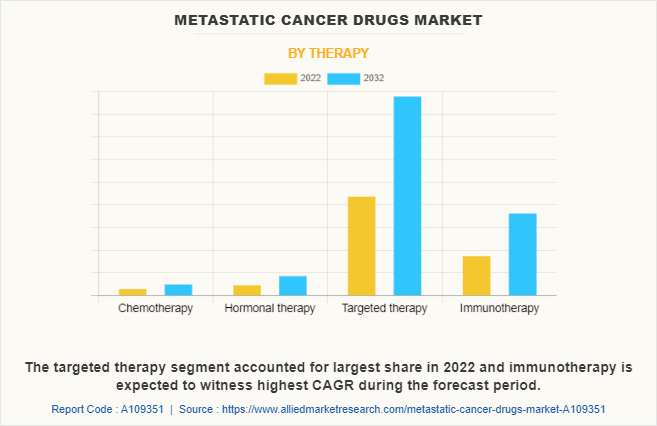
By Indication
The breast cancer segment accounted for largest metastatic cancer drugs market share in 2022, owing to rise in number of breast cancer cases diagnosed and wide availability of novel therapeutics for metastatic breast cancer treatment. However, the lung cancer is expected to register highest CAGR during the forecast period owing to increasing number of metastatic non-small cell lung cancer (NSCLC) cases, and rise in regulatory approvals.
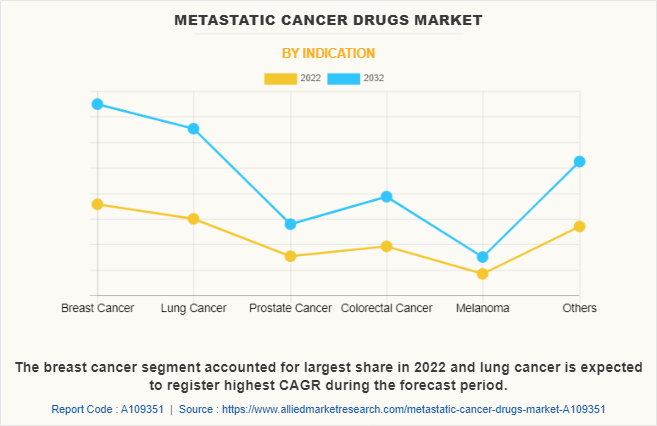
By Distribution Channel
The hospital pharmacies accounted for largest share in 2022, as hospital pharmacies owing to availability of wide range of specialized metastatic cancer drugs, including novel therapies and clinical trial medications. The drug stores and retail pharmacies segment is projected to register the highest CAGR during metastatic cancer drugs market forecast period, owing to accessibility of retail pharmacies everywhere and large chain of distribution networks. In addition, drug stores and retail pharmacies play an important role in providing education and counseling to patients about their medications, potential side effects, and the importance of adhering to their treatment plans.
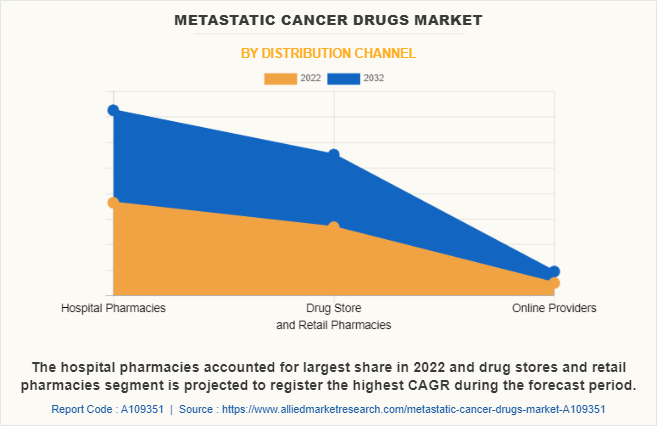
By Region
The market is analyzed across North America, Europe, Asia-Pacific, and LAMEA. North America accounted for largest metastatic cancer drugs market size in 2022 and is expected to remain dominant during the forecast period owing to presence of large patient population suffering from metastatic cancer, strong presence of key players, ease of drug availability, well developed healthcare infrastructure, favorable reimbursement policies in healthcare system, higher number of research, development, and innovation activities and upsurge in adoption of advanced therapeutics for metastatic cancer. However, Asia-Pacific is anticipated to witness notable growth owing to increase in investments for development of anti-cancer agents, increase in number of metastatic cancer cases and rise in awareness related to available treatment options, thereby driving the growth of market during the forecast period.
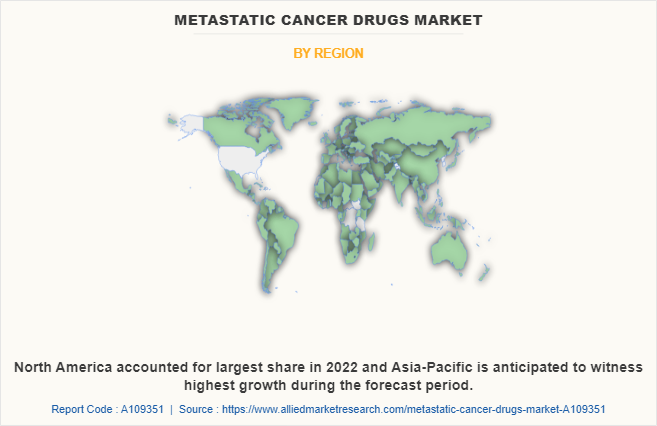
Presence of several major players, such as F. Hoffmann-La Roche Ltd., Novartis AG, Pfizer Inc., AstraZeneca, Eli Lilly and Company, Merck and Co., Inc., and advancement in manufacturing technology for development of effective treatment options for metastatic cancer in the region is expected to drive the growth of metastatic cancer drugs industry. In addition, various private organizations organize educating camps for awareness of metastatic cancer and treatment options available across the globe is expected to drive growth of market. Furthermore, the presence of well-established healthcare infrastructure and rise in adoption rate of new treatment options such as targeted therapy for metastatic cancer is expected to drive the market growth.
Asia-Pacific is expected to grow at the highest rate during the forecast period. The metastatic cancer drugs market growth in this region is attributable to the presence of key players in the region. The Asia Pacific region has made significant efforts in improving its healthcare infrastructure, including cancer care facilities and specialized oncology centers. The establishment of comprehensive cancer centers, advancements in diagnostic technologies and access to modern treatment modalities is expected to drive the market.
Further, Asia-Pacific offers profitable metastatic cancer drugs market opportunity, thereby registering the fastest growth rate during the forecast period, owing to the growing infrastructure of industries, rising in spending for cancer research, as well as well-established presence of domestic companies in the region. In addition, the rise in contract manufacturing organizations within the region provides great opportunity for new entrants in this region.
Competition Analysis
Competition analysis and profiles of the major players in the metastatic cancer drugs market, such as Novartis AG, Pfizer Inc., AstraZeneca, Eli Lilly and Company, Merck and Co., Inc., Bristol-Myers Squibb Company, Johnson and Johnson, Amgen Inc., Sanofi S.A. and F. Hoffmann-La Roche Ltd. are provided in the report. Major players have adopted collaboration, product launch, new product development and product approval as key developmental strategies to improve the product portfolio of the metastatic cancer drugs industry.
Recent Product Approvals in Metastatic Cancer Drugs Market
- In October 2022, Bristol Myers Squibb announced that the European Commission (EC) has approved the fixed-dose combination of Opdualag (nivolumab and relatlimab) for the first-line treatment of advanced (unresectable or metastatic) melanoma in adults and adolescents 12 years of age and older with tumor cell PD-L1 expression < 1%.
- In July 2023, AstraZeneca and Merck, known as MSD, outside of the United States and Canada, announced that LYNPARZA in combination with abiraterone and prednisone or prednisolone (abi/pred) has been approved by the U.S. Food and Drug Administration (FDA) for the treatment of adult patients with deleterious or suspected deleterious BRCA-mutated (BRCAm) metastatic castration-resistant prostate cancer (mCRPC).
Recent Product Launch in Metastatic Cancer Drugs Market
- In April 2020, Merck, known as MSD outside the United States and Canada, announced the U.S. launch of ONTRUZANT (trastuzumab-dttb), as a biosimilar of the reference biologic medicine Herceptin used in treating HER2 overexpressing metastatic breast cancer and metastatic gastric or gastroesophageal junction adenocarcinoma.
Recent Collaboration in Metastatic Cancer Drugs Market
- In September 2021, Novartis announced a collaboration with SOLTI Innovative Cancer Research (SOLTI) on HARMONIA, an international, randomized, Phase III, multicenter, open-label study of Kisqali (ribociclib) versus Ibrance (palbociclib), both in combination with endocrine therapy, in patients with hormone receptor-positive, human epidermal growth factor receptor 2-negative (HR+/HER2-) advanced or metastatic breast cancer with a HER2-enriched (HER2E) intrinsic subtype.
Key Benefits For Stakeholders
- This report provides a quantitative analysis of the market segments, current trends, estimations, and dynamics of the metastatic cancer drugs market analysis from 2022 to 2032 to identify the prevailing metastatic cancer drugs market opportunities.
- The market research is offered along with information related to key drivers, restraints, and opportunities.
- Porter's five forces analysis highlights the potency of buyers and suppliers to enable stakeholders make profit-oriented business decisions and strengthen their supplier-buyer network.
- In-depth analysis of the metastatic cancer drugs market segmentation assists to determine the prevailing market opportunities.
- Major countries in each region are mapped according to their revenue contribution to the global market.
- Market player positioning facilitates benchmarking and provides a clear understanding of the present position of the market players.
- The report includes the analysis of the regional as well as global metastatic cancer drugs market trends, key players, market segments, application areas, and market growth strategies.
Metastatic Cancer Drugs Market Report Highlights
| Aspects | Details |
| Market Size By 2032 | USD 137 billion |
| Growth Rate | CAGR of 7.3% |
| Forecast period | 2022 - 2032 |
| Report Pages | 313 |
| By Therapy |
|
| By Indication |
|
| By Distribution channel |
|
| By Region |
|
| Key Market Players | Bristol-Myers Squibb Company, Sanofi S.A., AstraZeneca plc, Eli Lilly and Company., Novartis AG, F. Hoffmann-La Roche Ltd., Pfizer Inc., Johnson & Johnson, Merck & Co., Inc., Amgen Inc. |
Analyst Review
This section provides various opinions in the global metastatic cancer drugs market. The global metastatic cancer drugs market is expected to grow owing to increase in demand for novel drugs and rise in investments for development of therapeutic agents for metastatic cancer globally are expected to offer profitable opportunities for the expansion of the market. In addition, favorable government initiatives and higher spending for metastatic cancer have piqued the interest of several companies to develop metastatic cancer drugs.
Further, increase in adoption of targeted drug therapy for metastatic cancer owing to enhanced efficacy, improved survival rates, and reduced toxicity as compared to conventional chemotherapy is expected to boost the growth of market. In addition, personalized medicine approaches, based on individual patient characteristics and tumor profiling have gained prominence in metastatic cancer treatment.
Furthermore, North America accounted for the largest share in 2022 and is expected to remain dominant during the forecast period owing to presence of large patient population suffering from metastatic cancer, strong presence of key players offering novel drugs, and favorable reimbursement policies in healthcare system. However, Asia-Pacific is anticipated to witness notable growth owing to increase in investments for development of anti-cancer agents, surge in number of metastatic cancer cases, and rise in awareness related to available treatment options.
The total market value of metastatic cancer drugs market is $67,711.32 million in 2022.
The market value of metastatic cancer drugs market in 2032 is $136,991.91 million.
The forecast period for metastatic cancer drugs market is 2023 to 2032.
The base year is 2022 in metastatic cancer drugs market.
Top companies such as F. Hoffmann-La Roche Ltd., Pfizer Inc., AstraZeneca, Merck & Co., Inc., and Novartis AG held a high market position in 2022. These key players held a high market position owing to the strong geographical foothold in North America, Europe, Asia-Pacific, and LAMEA.
The targeted therapy segment is the most influencing segment in metastatic cancer drugs market owing to a rise in adoption of targeted therapy in metastatic cancer treatment. In addition, recent advances in cellular technology have contributed to improving the understanding of tumor cells and their metabolism at molecular level, thus driving the need for targeted drug therapies for metastatic cancer treatment.
The major factor that fuels the growth of the metastatic cancer drugs market are increase in number of people suffering from metastatic cancer, surge in advancements for development of novel therapeutics, and rise in demand for advanced diagnostic technique for metastatic cancer detection.
Metastatic cancer, also referred to as stage IV cancer, is a term used to describe cancer that has spread from its original site (primary tumor) to other parts of the body.
Common treatment approaches for metastatic cancer include systemic therapies such as chemotherapy, hormonal therapy, targeted therapy, and immunotherapy.
Loading Table Of Content...
Loading Research Methodology...



